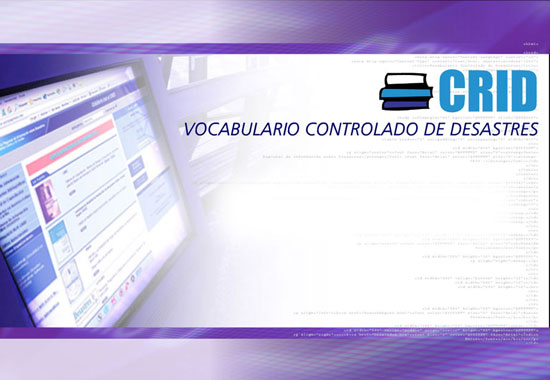|
Thesaurus
on Disaster Terminology: A Conceptual Tool for Information Retrieval
Irene
Céspedes O.
CRID

A
thesaurus is a vocabulary of controlled indexing language, formally
organized so that, a priori, relationships between concepts are
made explicit to be used in information retrieval systems
ALAN
GILCHRIST AND JEAN AITCHISON
A
thesaurus is a tool used mainly to improve processes for indexing
and retrieving information from a number of sources, and to establish
controlled terms to be used in a specific area. In addition, this
controlled vocabulary allows for the establishment of a searching
strategy through the use of standardized terms.
By
standardizing the terminology used in a specific field, this controlled
vocabulary seeks to facilitate the creation of objective conditions
required to advance cooperation and the exchange and transfer of
information among countries -particularly in a given geographic
region that shares the same language but varies or modifies the
same concepts.
Along
these lines, the Regional Disaster Information Center for Latin
America and the Caribbean (CRID) has developed the Disasters Controlled
Vocabulary (DCV). This document represents the efforts made by CRID
in order to provide people and institutions working on disaster-related
issues with a tool for indexing and retrieving relevant documents,
as well as for standardizing terms used in this field. Through these
two tasks, VCD users will be able to use a standardized terminology
to disseminate their experiences and information products in such
a controlled language that may also improve the exchange of knowledge.
The
DCV is a tool for content analysis of bibliographic information
which may be used as reference material ondisaster terminology.
This thesaurus is composed of a total of 951 terms structured in
a hierarchical fashion. Each term is available in three different
languages (Spanish, English and Portuguese) and most of them also
include definitions and scope notes.
Currently,
the DCV is being used by CRID’s information management staff
to index these terms. This process allows for the identification
of concepts that describe the information gathered within its DISASTER
database, which includes bibliographic and audiovisual material,
as well as electronic files. CRID expects that, in addition to serve
as reference material, the DCV becomes a valuable tool for experts
in different areas who may require a thesaurus to prepare reports
or scientific publications, as well as for translators and editors
of bibliographic material. Through their daily work aimed at indexing,
searching for and having access to new bibliography in the field
of disasters, CRID professional staff –who compiled most of
the terms included in this thesaurus-, try to discover expressions
in each language which may be considered descriptors or a new term
for the DCV. Once a term is identified, a definition applied to
disasters or related fields is included.
It
is worth mentioning that, in order to develop this DCV, CRID received
valuable contributions from experts in disasters and other related
areas, which enriched the thesaurus with new terms. In addition,
existing terms were reviewed and scope notes were included. Initially
conceived as a document that would facilitate the process of indexing
and locating CRID’s general collection (which currently has
more than 15,000 entries), the DCV is now being offered as a product
intended for promoting standardized terminology in the field of
disasters, and as a guide for documentation centers that manage
this type of information, to enable them to create their own databases.
The version already published includes terms in Spanish, organized
in three different sections:
•
Term hierarchy (structured by levels which presents all
terms according to general and specific categories);
• Alphabetical list of terms; and,
• A CD Rom containing the Disaster Controlled Vocabulary
(DCV): preliminary version.
In
order to continue updating this thesaurus, CRID welcomes the submission
of terms, which must meet the following requirements:
•
Be mentioned in at least three documents. Their biblio graphic references
must be also included.
• Include the scope note (definition) of each new term, and
quote the source from which it was taken.
• Include synonyms and other related terms.
• Place the term under the corresponding thematic category
(according to the term hierarchy established).
• If the term is included in Spanish or in English, the translation
into one of these languages must be included as well. If the term
proposed is in Portuguese or French, its translation into English
(at least) must be included.
For
further information or to obtain a CD-ROM of the full-text version
of this thesaurus, please contact CRID at crid@crid.or.cr,
or visit http://www.crid.or.cr/crid/esp/vocabulario_controlado.html
and go to Listado Alfabético de Términos (Alphabetical
List of Terms) to download the corresponding PDF file.
|




